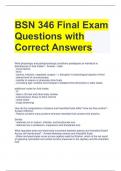Exam (elaborations)
BSN 346 Final Exam Questions with Correct Answers
- Course
- Institution
BSN 346 Final Exam Questions with Correct Answers What physiologic and pathophysiologic conditions predispose an individual to disturbances in fluid intake? - Answer-- habit - social factors - thirst - trauma, infection, neoplasia, surgery --> disruption in physiological signals of th...
[Show more]



